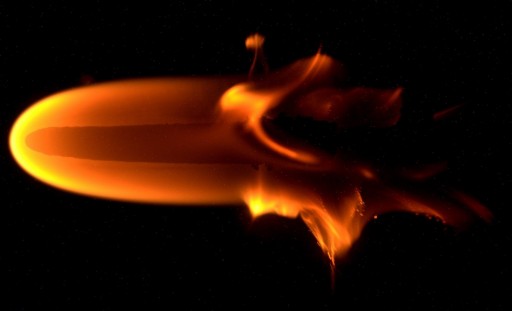Group Combustion

Group Combustion is a study performed by NASA and the Japan Aerospace Exploration Agency and goes by the full name ‘Elucidation of Flame Spread and Group Combustion Excitation Mechanism of Randomly-distributed Droplet Clouds.’ The goal of the experiment is to use the Multi-Purpose Small Payload Rack in the Kibo module to perform experiments testing a theory that fuel sprays change from a partial to group combustion as flames spread across the collection of droplets.
The experiment uses decane (C10H22) droplets that are arranged on thin-fiber lattice points before being ignited while the flame and droplet positions as well as the temperature distribution are measured in the moments the flame is spreading. Group combustion makes use of the unique environment in microgravity to study this phenomenon that can not be observed on Earth where convection will quickly disperse the droplets and combustion products.
The understanding of the combustion of liquid fuel spray is critical for the modeling of combustion processes and an essential part in combustion science. Spray combustion is used in a number of systems including engines in motor vehicles as well as liquid rocket engines. The burning state of group combustion in spray combustion systems occurs depending on a number of conditions and is characterized by one flame surrounding many droplets. Group Combustion is important for a stable combustion of sprays and its deliberate excitation requires better understanding of its mechanism and a way of predicting spray combustion behavior. Therefore it is essential to obtain a clarification of the flame spread mechanism in sprays using the microgravity environment which enables droplet sizes to be increased to make a measurement possible.
The droplets of n-decane are deployed on the crossing points of a 30 by 30 Silicon Carbide fiber lattice or on a single SiC fiber.
A droplet located on the edge is then ignited by an electrically heated wire to initiate the flame spread across the remaining droplets. The experiment will look at the effects of different droplet arrangement, droplet spacing, and initial droplet diameter. The data collected by Group Combustion will be analyzed by comparing it to a flame spread model for the optimization of models and prediction methods.
Better models of spray combustion will lead to improvements in the design of advanced spray combustion systems such as aero engines, gas turbines and industrial furnaces. Rocket engines use spray combustion of liquid propellants after being injected into the combustion chamber. The high speeds at which propellant components are injected into rocket engines make it impossible to analyze the droplet-flame interaction within the combustion chamber. The Group Combustion experiment will deliver data for the improvement of numerical simulations that can be used to predict spray combustion in rocket engines. Other benefits of the experiment include improvements made in cleaner, energy-efficient engines.
